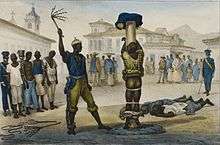Cropping (punishment)
Cropping is the removal of a person's ears as an act of physical punishment.[1] It was performed along with the pillorying or immobilisation in the stocks,[2][3] and sometimes alongside punishments such as branding or fines.[2] The punishment is described in Victor Hugo's The Hunchback of Notre-Dame.[4]
| Part of a series on |
| Corporal punishment |
|---|
 |
| By place |
| By implementation |
| By country |
| Court cases |
| Politics |
Description
Cropping sometimes occurred as a standalone punishment (such as in the case of William Prynne for seditious libel),[5] where criminals' ears would be cut off with a blade. Cropping was also a secondary punishment to having criminals' ears nailed to the pillory (with the intention that their body movements would tear them off).[5] In 1538 Thomas Barrie spent a whole day with his ears nailed to the pillory in Newbury, England, before having them cut off to release him.[6]
History
Cropping is mentioned in ancient Assyrian law and the Babylonian Code of Hammurabi.
Cropping was quite rare in England, but more common in Guernsey.[7] Notable cases of cropping in England include Thomas Barrie in 1538, who reputedly died from shock following his cropping,[6] and John Bastwick, William Prynne, and Henry Burton in 1637.[8] In the 16th century, Henry VIII amended the laws on vagrancy to decree that first offences would be punished with three days in the stocks, second offences with cropping, and third offences with hanging.[9]
Records show that croppings took place in the United States in the late 18th century, particularly in states such as Pennsylvania[2] and Tennessee.[3]
From page 153 of Reverend Samuel Peters' General History of Connecticut, written during the colonial period, there is this account:
Newhaven is celebrated for giving the name of "Pumpkin Heads" to all of New Englanders. It originated from the "Blue Laws" which enjoined every male to have his hair cut round by a cap. When caps are not to be had, they substituted a hard shell of a pumpkin, which being put on the head every Saturday, the hair is cut by the shell all round the head…….. and fourthly, such persons as have lost their ears for heresy, and other wickedness, cannot conceal their misfortune and disgrace.
In Rhode Island, cropping was a punishment for crimes such as counterfeiting money, perjury, and "burning houses, barns, and outbuildings" (but not amounting to arson).[10] Cropping (along with the pillory and stocks) was abolished in Tennessee in 1829, with abolition further afield starting from approximately 1839.[11]
See also
Footnotes
- Stronghold Knights (2010)
- Warner (2005, p. 244)
- Corlew, Folmsbee & Mitchell (1990, p. 163)
- Hugo (1831, p. 139)
- Du Cane (2005, p. 13)
- Ford (2001)
- Ogier (1996, p. 14)
- Dearmer (2009, p. 189)
- Adams (1998, p. 41)
- Prison Discipline Society (1826, p. 19)
- Kellaway (2003, p. 64)
Sources
- Adams, Robert (1998), The Abuses of Punishment, Basingstoke, Hampshire: Palgrave Macmillan, ISBN 0-312-17617-1
- Corlew, Robert Ewing; Folmsbee, Stanley John; Mitchell, Enoch L (1990), Tennessee: A Short History, Knoxville, TN: University of Tennessee Press, ISBN 0-87049-647-6
- Dearmer, Percy (2009), Religious Pamphlets, Charleston, SC: BiblioBazaar, ISBN 1-115-39089-9
- Du Cane, Edmund F. (2005), The Punishment and Prevention of Crime, Whitefish, MT: Kessinger Publishing, ISBN 1-4179-7160-6
- Ford, David Nash (2001), Ghosts from Berkshire Places Beginning with 'N', Finchampstead, Berkshire: Royal Berkshire History, retrieved 25 October 2010
- Hugo, Victor (1831), The Hunchback of Notre Dame (Notre-Dame de Paris), ISBN 1-4209-3381-7
- Kellaway, Jean (2003), The History of Torture and Execution, ISBN 1-58574-622-3
- Ogier, Darryl Mark (1996), Reformation and Society in Guernsey, Woodbridge, Suffolk: Boydell & Brewer, ISBN 0-85115-603-7
- Prison Discipline Society (1826), Annual Report of the Board of Managers, Boston, MA: Prison Discipline Society
- Stronghold Knights (2010), The Pillory (1100 - 1840 AD), retrieved 27 October 2010
- Warner, A (2005), History of Allegheny County, Pennsylvania, Westminster, MD: Heritage Books, ISBN 0-7884-4612-6